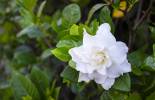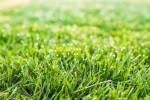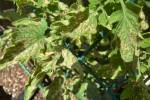Good care should keep plums healthy, free of borers
There is still room in a master food preserver class that has been scheduled for all day Thursday and Friday, Sept. 1 and 2. The class will cover all phases of home food preservation. Graduates will become certified master food preservers qualified to teach home food preservation techniques as volunteers.
Those interested should contact me at extremehort@aol.com or call the master gardener help line at 702-222-3130 to enroll. Class size is limited and there is a fee for the class. Spots are available for those who do not want to become volunteers for an additional fee.
Q: We have several of the red plum trees that look diseased. The gardener said they have weevils. He suggested a treatment that might help. I forgot what it was. Are they savable or not? Some are worse than others .
A: I do not know of weevils infesting the purple leaf plums, but borers are a possibility and that may be what the gardener was referring to. The gardener is right that a pesticide might help, but unless the problems are corrected that caused this situation it is a losing effort. These trees are not usually destined to have borers but have gotten them because of their location or care.
There are not very many treatments that are effective. Making sure they are not planted in rock landscapes and have enough water but are not watered too frequently are the best solutions.
They need regular care with fertilizers and appropriate pruning. They can live a long time, at least for a plum; you should expect about 20 to 30 years under good care.
It is hard to know if they are savable or even worth saving. I think that is in the eye of the owner. Generally speaking, if more than half of the tree is dead, it is not worth trying to keep.
Q: Our outdoor, 7-foot, 4-year-old plumeria tree suffered severe cold injury this winter and died back almost to the ground. There are several healthy-looking offshoots growing from the remnants of its trunk. Is there a way to control the height of plumeria, like pruning, so that we can better protect it from low temperatures?
A: Pruning won't really protect this common Hawaiian plant from freezing weather. The two problems are how cold it gets and wind. Together they are worse than either one alone.
Unless you want to build a structure around it and keep it warm during freezing weather, the best strategy would be to treat it more like a shrub or bush rather than a tree. However, larger trees have more resistance to cold in their thick trunks and limbs than a shrub does. I think it is because the larger trunk and limbs have greater mass .
It is possible that once the tree form has frozen back to the ground, you may be able to retrain a new trunk from new sprouts at the base or crown. Because it will have a large root system established, regrowth should be very fast.
Never fertilize past July 1 on winter-tender plants. Do not prune it until all freezing weather has passed. Pack it with mulch around the base just prior to freezing weather. After freezing weather has passed, remove the mulch.
If it dies back, hopefully it will die back to the mulch line and no further. If there are really low temperatures, it will kill it back to the ground or completely. The mulch will not matter much then. Those are the risks and precautions we must take when we try to keep woody perennials here that are tender.
Q: I have had a Meyer lemon tree in a wooden barrel on my patio for three years. It gets sun from about noon and later. I water it well three times a week and fertilize every two to three weeks. I had hundreds of blossoms and many bees but no lemons. They form small nubs, turn yellow and fall. What am I doing wrong?
A: My initial guess would be watering, even though you seem to be watering adequately. If the soil gets too dry, they will drop the fruit. When watering, water until it runs out the bottom of the barrel, making sure the water wets the soil and does not run down the sides.
When soil becomes overly dry between irrigations, it will be hydrophobic and repel water, causing it to run down the sides of the container and not wetting the soil thoroughly. This happens frequently if container soils were used that have a lot of peat moss in them or other organics.
If this watering is on an irrigation controller, try splitting the watering into two applications, about 30 minutes apart, splitting the total application in half. If you are hand watering, fill the container twice, one right after another.
Make sure you have enough head space on top of the soil to allow for the application of about 3 inches of water, flooding the surface. Make sure the soil does not completely fill the container.
If you have some trouble wetting the soil, add about a tablespoon of Ivory liquid detergent to a bucket of water and apply that first. You could probably use other liquid detergents as well but some are not very refined. Don't use a cheap one with additives like scents and lotions.
If the container is in full sun, then the container can overheat the roots. It is best to double pot containers so the outside surface of the container is shaded from direct sunlight.
Q: I am interested in planting various fruits in my backyard. One that I am curious about is growing blueberries in our region. Do you know how they do here? Would you have any recommendations? I did not realize the varieties of blueberry plants that are out there. In my search I also came across pink lemonade blueberries. I am definitely interested, but I do not want to put forth the effort if they will not be a productive plant in our area.
A: This is the case where your gardening skills are going to be challenged. They are definitely not suited to our climate and definitely not suited to our soils. So let's give it a try.
This means we have to modify the climate they are in as much as possible and also the soils. Pick a microclimate in your landscape that will be as cool as possible yet still provide six to eight hours of sunlight every day. This would most likely be an east or north side of a landscape that avoids late afternoon direct sunlight. Find a location or create a location that is protected from prevailing strong winds.
Next, modify the soil. Blend anywhere from half to 2/3 of the existing soil with a good quality compost. To this mix, add sulfur that is as finely ground as you can find or in a liquid form. If you are not opposed to it, aluminum sulfate can help lower the alkalinity. It is not used much any more and may be hard to find.
Water the soil thoroughly and let it drain several times before planting. Use only Southern high bush blueberries in the planting holes and space them according to the directions. Stake the plants securely in the soil the first season of growth.
You will need pollenizers so make sure you get the correct blueberries together for good fruit set. Drip irrigation can be used or you can flood the area with water from bubblers. Cover the planting area with 3-4 inches of wood mulch, keeping the mulch about 6 inches away from stems that enter the soil.
Grow them for one season and see how they do. If you see signs of leaf scorching on the edges, you might want to put 30 percent shade cloth over the top of them to help them a bit from intense sunlight. Every year you should be adding compost and acidifying the soil with finely ground sulfur or aluminum sulfate plus a good fertilizer and a soil-applied iron chelate containing EDDHA. This is done in the spring before you see new growth. This should help get you started.
Bob Morris is a horticulture expert living in Las Vegas. Visit his blog at xtremehorticulture.blogspot.com.























